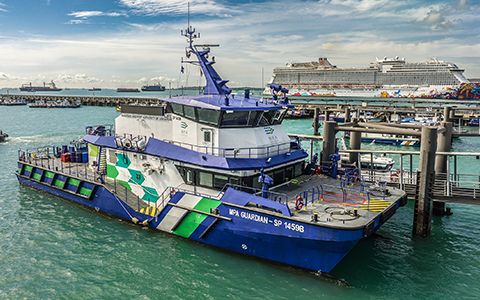Rolls-Royce, Singapore Institute of Technology Developing Tech for Maritime Industry
Rolls-Royce will install the NautIQ Foresight system on a pilot vessel, collecting performance data to improve automation for future testing.
During Singapore Maritime Week, Rolls-Royce and the Singapore Institute of Technology (SIT) announced a partnership to develop and improve equipment health and fleet management technologies for autonomous ships, harbor crafts, and vessels with hybrid propulsion systems.
“We see the joint research project as an important step in the further development of autonomous ships and ships with hybrid technologies,” said Kevin Daffey, Senior Vice President of Mobile Automation at Rolls-Royce Power Systems. “Singapore, as a center for sustainable shipping, is the ideal location for this project, with all the progressive institutions we are partnering with here. We are thus promoting the reduction of CO2 emissions and supporting our customers with digital systems and even better service in line with our strategic goals.”
The partnership’s objective is to develop an efficient automation solution that will enhance the availability, fuel consumption, and emissions of hybrid and/or electric-powered ships and entire fleets.
“SIT’s collaboration with Rolls-Royce will drive the future of intelligent and sustainable maritime operations,” said Professor Susanna Leong, Vice President (Applied Research) at SIT. “This partnership reflects SIT’s commitment to applied research that delivers real-world impact, leveraging AI, advanced analytics, and condition monitoring to enhance ship autonomy, optimize fleet performance, and reduce carbon emissions. SIT will contribute our expertise in intelligent systems and sustainability, while working with industry captains to develop practical solutions that address the evolving needs of the maritime sector.”
MPA Guardian patrol craft; image credit: Rolls-Royce

The Maritime and Port Authority of Singapore (MPA) will dedicate a multi-purpose, hybrid patrol craft for the pilot project: the MPA Guardian, equipped with two mtu Series 16V2000 engines. Rolls-Royce will install the mtu NautIQ Foresight equipment health management system to collect vessel data and optimize operations before moving on to additional testing.
Maritime Automation
The mtu NautIQ automation portfolio, applicable to new-builds and retrofittable to older vessels, allows monitoring and control from “bridge to propeller.” The “Master” iteration is Rolls-Royce’s most recent Integrated Platform Management System (IPMS), which enables the integration or future-proof upgrade of additional hardware, software, and auxiliaries throughout a vessel’s lifecycle, offering customers long-term planning and reliability.
“There are several advantages to our automation systems: The crew can focus on its main tasks and competencies—for small crews, this is a big advantage,” said Simon Gallagher, Director of mtu NautIQ Solutions, Rolls-Royce Power Systems. “The technical complexity and maintenance tasks can be managed by the fleet-management team on land. Decisions are made based on live data, not on historical data. Cloud analytics and AI technologies can be made available for operators.”
More Rolls-Royce News
In March, the German Customs Administration selected Rolls-Royce to supply 15 mtu 16V4000 gas engines for four newbuild customs vessels, satisfying a modernization, propulsion, and on-board power program for maritime transport in the North Sea and Baltic Sea. Rolls-Royce also signed a long-term service agreement for 11 fleet vessels, ensuring reliable operation for its mtu engines.
The first commissioned, 67-meter vessel, dubbed the Rügen, is powered by four mtu engines, two controllable pitch propellers, electric motors, and two on-board power generators. It can operate at sea for several weeks in different modes: gas-electric, gas-mechanical, and booster. The booster mode allows the ship to reach 23 knots and activates all four main engines, electric engines, and on-board units—each primary engine generates 1,492-kW output.